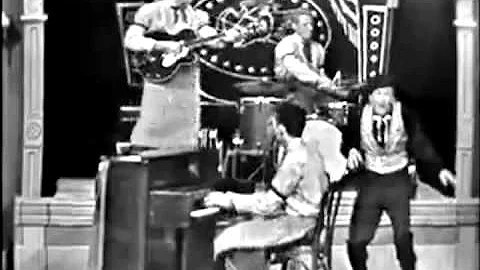Roland L Hawkins
age ~82
from Prosperity, SC
- Also known as:
-
- Donna D Hawkins
- Ronald L Hawkins
- Robert L Hawkins
- Rickey L Hawkins
- Rl Hawkins
- Ron L Hawkins
Roland Hawkins Phones & Addresses
- Prosperity, SC
- Florence, SC
- Spartanburg, SC
- Simpsonville, SC
- Redmond, WA
Resumes

Roland Hawkins
view source
Roland Hawkins
view source
Roland Hawkins
view source
Roland Hawkins
view source
Roland Hawkins
view sourceLocation:
United States
Us Patents
-
Texturing Finish For Synthetic Filaments
view source -
US Patent:40691608, Jan 17, 1978
-
Filed:Jan 20, 1975
-
Appl. No.:5/542683
-
Inventors:Roland L. Hawkins - Spartanburg SC
-
Assignee:Hoechst Fibers Industries, Division of American Hoechst Corporation - Spartanburg SC
-
International Classification:D06M 1316
D06M 1320
D06M 1326 -
US Classification:252 89
-
Abstract:An improved, low fuming, thermally stable, texturing finish for a synthetic filamentary material is disclosed comprising 40 to 75 percent of a lubricant, exemplified by pentaerythritol tetrapelargonate; 20 to 50 percent of an emulsifier, exemplified by condensates of castor oil with from about 2 to about 12 moles of ethylene oxide; 2 to 20 percent of an antistat-auxiliary emulsifier, such as a neutralized phosphate ester of an alcohol; and optionally 0 to 2 percent of a thermal stabilizer, exemplified by a condensate of 3-methyl-6-tert-butylphenol with crotonaldehyde. An oil in water emulsion is produced having an oil content of from about 5 to 20 weight percent.
-
Staple Fiber, Finish Therefor And Process For Use Of Same
view source -
US Patent:42948835, Oct 13, 1981
-
Filed:Aug 17, 1979
-
Appl. No.:6/067294
-
Inventors:Roland L. Hawkins - Spartanburg SC
-
Assignee:Hoechst Fibers Industries, Div. of American Hoechst Corporation - Spartanburg SC
-
International Classification:D02G 300
-
US Classification:428361
-
Abstract:A composition for short cut, synthetic polymeric staple fibers that are used in a wet lay application for the production of nonwovens is disclosed and claimed herein along with a fiber having the finish thereon and the process for dispersing the fiber in an aqueous medium. Synthetic polymeric filaments are cut into staple lengths, generally in a range of from about 1/4 to about 3 inches in length, and are dispersed in an aqueous medium in conjunction with a composition that includes as an essential ingredient, an ethoxylated primary emulsifier that contains at least five moles of ethylene oxide, and exhibits a surface tension of at least 30 dynes per centimeter in a 0. 10 weight percent aqueous solution at 25 degrees Centigrade plus or minus 2 degrees Centigrade. Optionally, a lubricant may be added to the finish composition to improve processability of the fiber during manufacture. The lubricant should be compatible with the primary emulsifier.
-
Staple Fiber, Finish Therefor And Process For Use Of Same
view source -
US Patent:41371810, Jan 30, 1979
-
Filed:Jul 22, 1977
-
Appl. No.:5/818127
-
Inventors:Roland L. Hawkins - Spartanburg SC
-
Assignee:Hoechst Fibers Industries - Spartanburg SC
-
International Classification:D06M 1310
-
US Classification:252 89
-
Abstract:A composition for short cut, synthetic polymeric staple fibers that are used in a wet lay application for the production of nonwovens is disclosed and claimed herein along with a fiber having the finish thereon and the process for dispersing the fiber in an aqueous medium. Synthetic polymeric filaments are cut into staple lengths, generally in a range of from about 1/4 to about 3 inches in length, and are dispersed in an aqueous medium in conjunction with a composition that includes as an essential ingredient, an ethoxylated primary emulsifier that contains at least five moles of ethylene oxide, and exhibits a surface tension of at least 30 dynes per centimeter in a 0. 10 weight percent aqueous solution a 25. degree. C. plus or minus 2. degree. C. Optionally, a lubricant may be added to the finish composition to improve processability of the fiber during manufacture.
-
Staple Fiber, Finish Therefor And Process For Use Of Same
view source -
US Patent:41795431, Dec 18, 1979
-
Filed:Aug 19, 1976
-
Appl. No.:5/715719
-
Inventors:Roland L. Hawkins - Spartanburg SC
-
Assignee:Hoechst Fibers Industries, Division of American Hoechst Corporation - Spartanburg SC
-
International Classification:D02G 300
-
US Classification:428361
-
Abstract:A composition for short cut, synthetic polymeric staple fibers that are u in a wet lay application for the production of nonwovens is disclosed and claimed herein along with a fiber having the finish thereon and the process for dispersing the fiber in an aqueous medium. Synthetic polymeric filaments are cut into staple lengths, generally in a range of from about 1/4 to about 3 inches in length, and are dispersed in an aqueous medium in conjunction with a composition that includes as an essential ingredient, an ethoxylated primary emulsifier that contains at least five moles of ethylene oxide, and exhibits a surface tension of at least 30 dynes per centimeter in a 0. 10 weight percent aqueous solution at 25 degrees Centigrade plus or minus 2 degrees Centigrade. Optionally, a lubricant may be added to the finish composition to improve processability of the fiber during manufacture. The lubricant should be compatible with the primary emulsifier.
-
Apparatus For Crimping Tow And Application Of Finish To The Tow
view source -
US Patent:54190231, May 30, 1995
-
Filed:Aug 23, 1994
-
Appl. No.:8/294893
-
Inventors:Roland L. Hawkins - Spartanburg SC
Lotfy L. Saleh - Charlotte NC -
Assignee:Hoechst Celanese Corporation - Somerville NJ
-
International Classification:D02G 112
-
US Classification:28267
-
Abstract:An apparatus for crimping continuous tow of textile material and application of the finish to the crimped continuous tow, including a pair of rollers and a stuffer box chamber having two regions therein. In particular, the stuffer box chamber has a first region for crimping the tow and a larger second region for application of a finish to the tow. Using the novel apparatus to crimp the tow and apply finish thereto, improves adherence of the finish to the tow.
-
Texturing Finish For Synthetic Filaments
view source -
US Patent:41156218, Sep 19, 1978
-
Filed:Nov 11, 1977
-
Appl. No.:5/850540
-
Inventors:Roland L. Hawkins - Spartanburg SC
-
International Classification:B05D 302
B32B 2703 -
US Classification:428395
-
Abstract:An improved, low fuming, thermally stable, texturing finish for a synthetic filamentary material is disclosed comprising 40 to 75 percent of a lubricant, exemplified by pentaerythritol tetrapelargonate; 20 to 50 percent of an emulsifier, exemplified by condensates of castor oil with from about 2 to about 12 moles of ethylene oxide; 2 to 20 percent of an antistat-auxiliary emulsifier, such as a neutralized phosphate ester of an alcohol; and optionally 0 to 2 percent of a thermal stabilizer, exemplified by a condensate of 3-methyl-6-tert-butylphenol with crotonaldehyde. An oil in water emulsion is produced having an oil content of from about 5 to 20 weight percent.
-
Synthetic Fiber Having High Neutralized Alkyl Phosphate Ester Finish Level
view source -
US Patent:48163368, Mar 28, 1989
-
Filed:Apr 2, 1987
-
Appl. No.:7/034130
-
Inventors:Anthony L. Allou - Inman SC
Roland L. Hawkins - Spartanburg SC -
Assignee:Hoechst Celanese Corporation - Somerville NJ
-
International Classification:D02G 300
-
US Classification:428361
-
Abstract:A two-component staple fiber finish is disclosed which renders polyester staple fiber having low to normal modulus and tenacity-at-break fit for "100%" open end spinning. A synthetic fiber having from about 0. 08 to about 0. 15 weight percent, based on the total weight of the fiber, of a primary finish comprising (a) from 25 to 85 weight percent of at least one alkyl phosphate ester salt, and (b) from 15 to 75 weight percent of a second component selected from the group consisting of quaternary trialkyl ethyl ammonium ethosulfate salts and the reaction products of polyoxyethylene ethers and C. sub. 8 -C. sub. 22 fatty acids is claimed. The use of a secondary lubricant to enhance the carding and drawing characteristics of the staple fiber is also disclosed.
-
Staple Fiber, Finish Therefor And Process For Use Of Same
view source -
US Patent:48571482, Aug 15, 1989
-
Filed:Aug 17, 1979
-
Appl. No.:6/067465
-
Inventors:Roland L. Hawkins - Spartanburg SC
-
Assignee:Hoechst Fibers Industries - Spartanburg SC
-
International Classification:D21F 1100
-
US Classification:1621572
-
Abstract:A composition for short cut, synthetic polymeric staple fibers that are used in a wet lay application for the production of nonwovens is disclosed and claimed herein along with a fiber having the finish thereon and the process for dispersing the fiber in an aqueous medium. Synthetic polymeric filaments are cut into staple lengths, generally in a range of from about 1/4 to about 3 inches in length, and are dispersed in an aqueous medium in conjunction with a composition that includes as an essential ingredient, an ethoxylated primary emulsifier that contains at least five moles of ethylene oxide, and exhibits a surface tension of at least 30 dynes per centimeter in a 0. 10 weight percent aqueous solution at 25 degrees Centigrade plus or minus 2 degrees Centigrade. Optionally a lubricant may be added to the finish composition to improve processability of the fiber during manufacture. The lubricant should be compatible with the primary emulsifier.
Medicine Doctors

Roland B. Hawkins
view sourceSpecialties:
Radiation Oncology
Work:
Ochsner ClinicOchsner Clinic Radiation Oncology
1514 Jefferson Hwy FL 1, New Orleans, LA 70121
5048423440 (phone), 5048422037 (fax)
1514 Jefferson Hwy FL 1, New Orleans, LA 70121
5048423440 (phone), 5048422037 (fax)
Education:
Medical School
Washington University School of Medicine
Graduated: 1980
Washington University School of Medicine
Graduated: 1980
Languages:
English
Spanish
Vietnamese
Spanish
Vietnamese
Description:
Dr. Hawkins graduated from the Washington University School of Medicine in 1980. He works in New Orleans, LA and specializes in Radiation Oncology. Dr. Hawkins is affiliated with Ochsner Medical Center Jefferson Highway.
Classmates

Roland Hawkins
view sourceSchools:
Douglass High School Upper Marlboro MD 2001-2005

Roland Hawkins | Frankfur...
view source
Frankfurt American High S...
view sourceGraduates:
Roland Hawkins (1967-1971),
Charles Kift (1966-1970),
Ralph Treciokas (1977-1981),
Dawn Osteen (1955-1959)
Charles Kift (1966-1970),
Ralph Treciokas (1977-1981),
Dawn Osteen (1955-1959)
Googleplus

Roland Hawkins

Roland Hawkins

Roland Hawkins
Myspace
Youtube

Roland Hawkins
view source
Roland Hawkins
view source
Roland Hawkins
view source
Roland Hawkins
view source
Carla Roland Hawkins
view source
Roland Hawkins
view source
Roland Hawkins
view source
Roland Hawkins
view sourceGet Report for Roland L Hawkins from Prosperity, SC, age ~82





